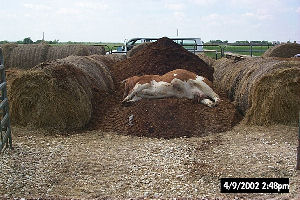
By Amy Millmier Schmidt, UNL Livestock Bioenvironmental Engineer
Nebraska used to limit mortality composting to carcasses weighing less than 600 lbs, but this restriction has been removed from state statute, opening the door to a new carcass disposal option for beef cattle and other large livestock. Although Nebraska has maintained a size restriction on mortality composting for many years, other states have successfully demonstrated that large carcasses, including beef cattle, dairy cattle, and horses, can be effectively composted.
Most farms, ranches, or feeding operations normally have all of the necessary materials and equipment on hand to create a successful composting program. Scraped manure, spilled or spoiled feed, and chopped straw or corn stalks can be combined to create a very effective pile material. The basic design of a carcass compost pile includes a 24-inch base of absorbent material (wood shavings, sawdust, etc.) on which mortalities are placed and then covered with additional pile material. During the composting process, microbes in the pile break down carcass tissue into a stable organic residue while producing heat, moisture, and carbon dioxide.
Monitoring heat and moisture in the pile is important to ensure optimum success of the composting process. Appropriate moisture ensures that microbial activity will generate heat to effectively kill pathogens and weed seeds in the pile. Internal pile temperatures of 120 to 160 degrees F indicate successful heating. For windrow composting (Figure 1 http://go.unl.edu/yvdy) or bin composting (Figure 2 http://go.unl.edu/kgcd), a temperature of 131 degrees F should be maintained for at least three consecutive days during each heating cycle. Temperature measurements should be made at several locations within the windrow or bin to ensure even heating throughout the pile. Typically, an initial 90-day heating cycle is followed by turning the pile, adding pile material and moisture, if needed, and allowing the pile to experience a second heating cycle. A third heating cycle may be needed, depending on the condition of the carcass(es) at the end of the second heating cycle. Large carcasses can take up to nine months to fully decompose. Bones that remain after the soft tissue is decomposed will need to be returned to the pile for further decomposition.
The term “compost” has been used to describe many products that have not been through sufficient heating cycles to destroy harmful pathogens and weed seeds. Mature compost will have an earthy scent, dark color, and consistent texture. Successfully producing this desirable product takes time and proper pile management.
To determine optimum pile design and operating considerations for Nebraska conditions, and to demonstrate large animal carcass composting as a mortality disposal method in the state, UNL assistant professor of Biological Systems Engineering and Animal Science, Amy Millmier Schmidt, and NRCS State Environmental Engineer, Jim Hicks, are working together to conduct on-farm composting trials at several locations in Nebraska. Grant funding to support the project has been requested and will support monitoring potential environmental impacts of large animal mortality composting. For additional information about composting mortalities, contact Schmidt at aschmidt@unl.edu or (402) 472-0877.